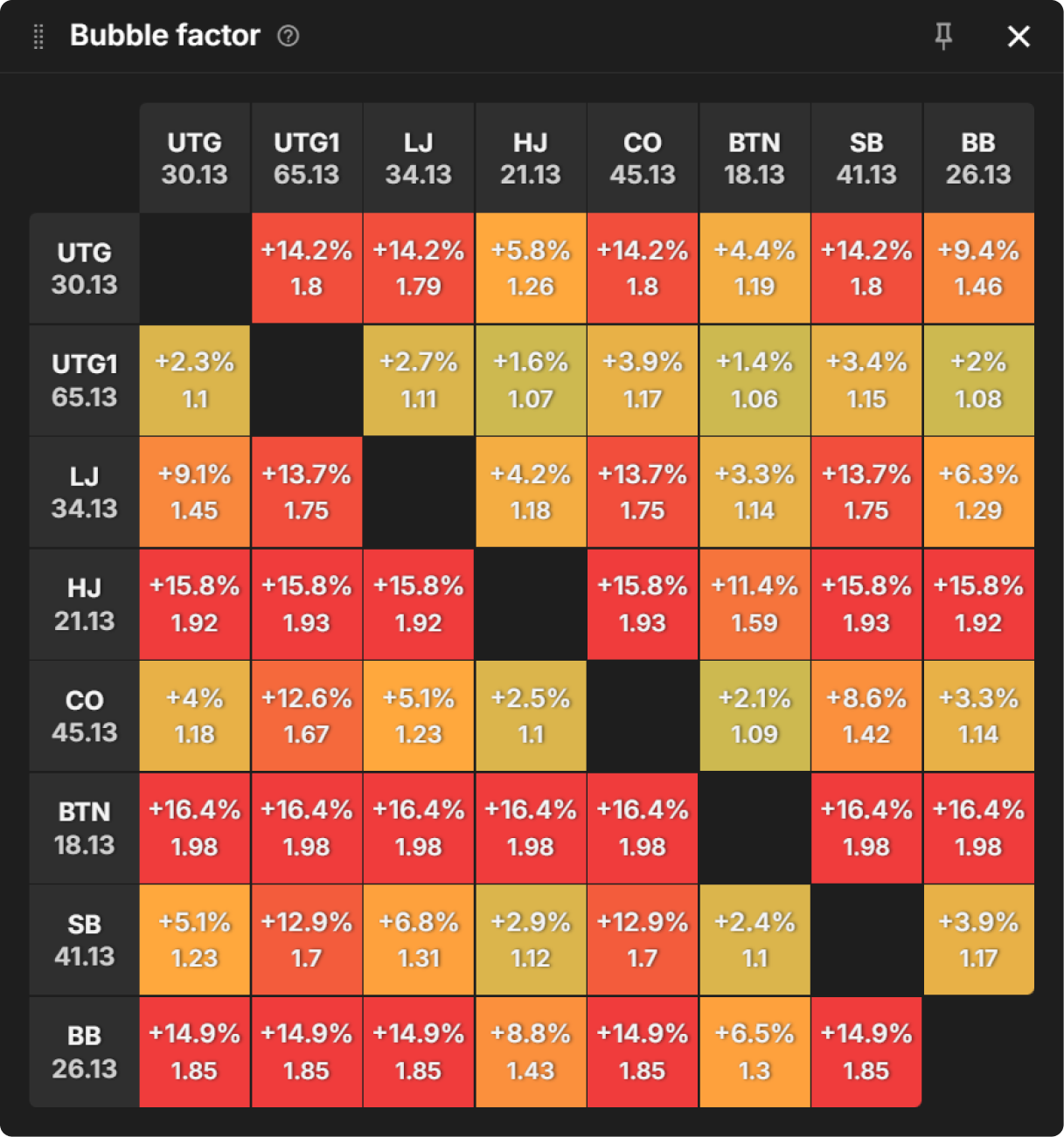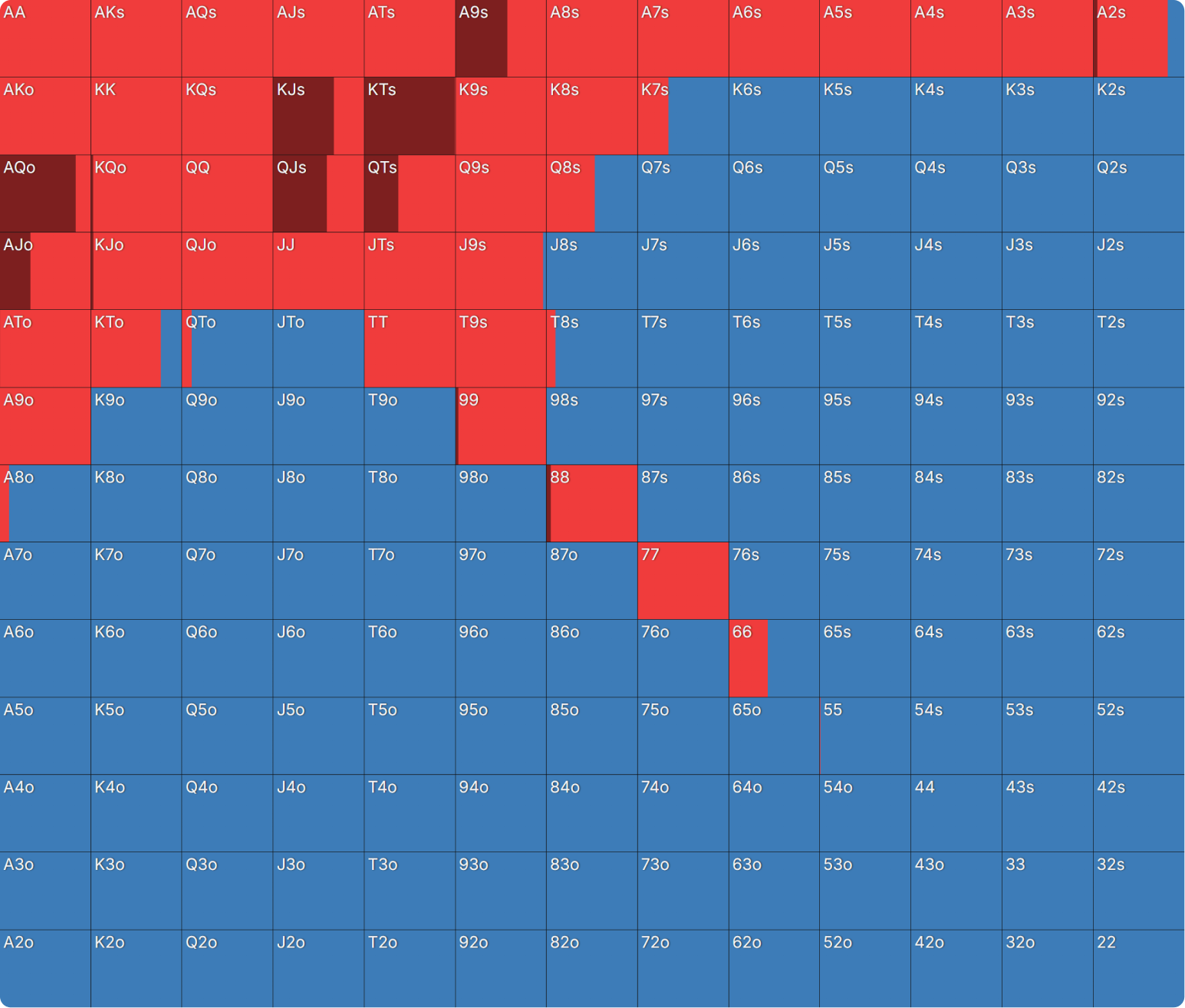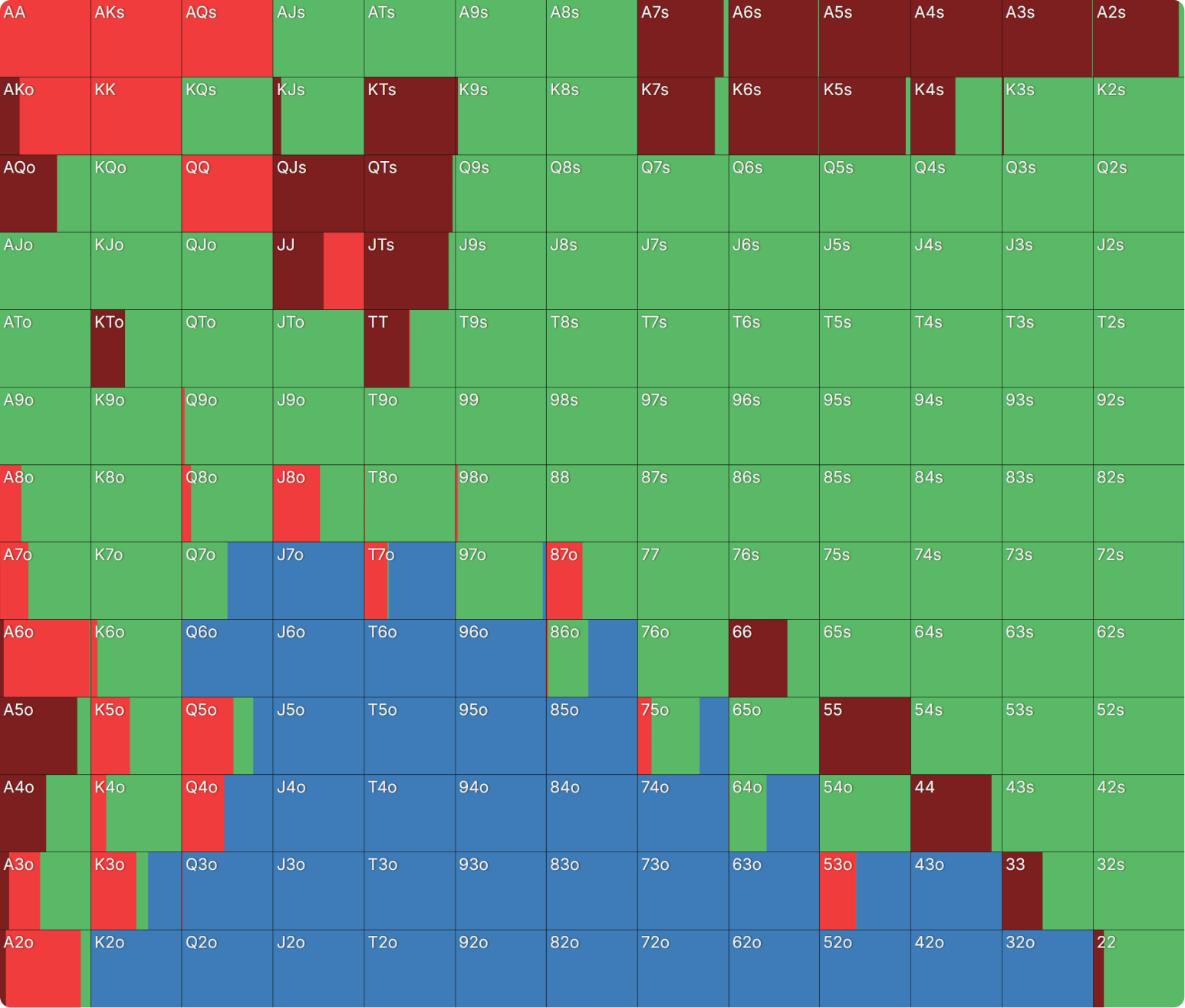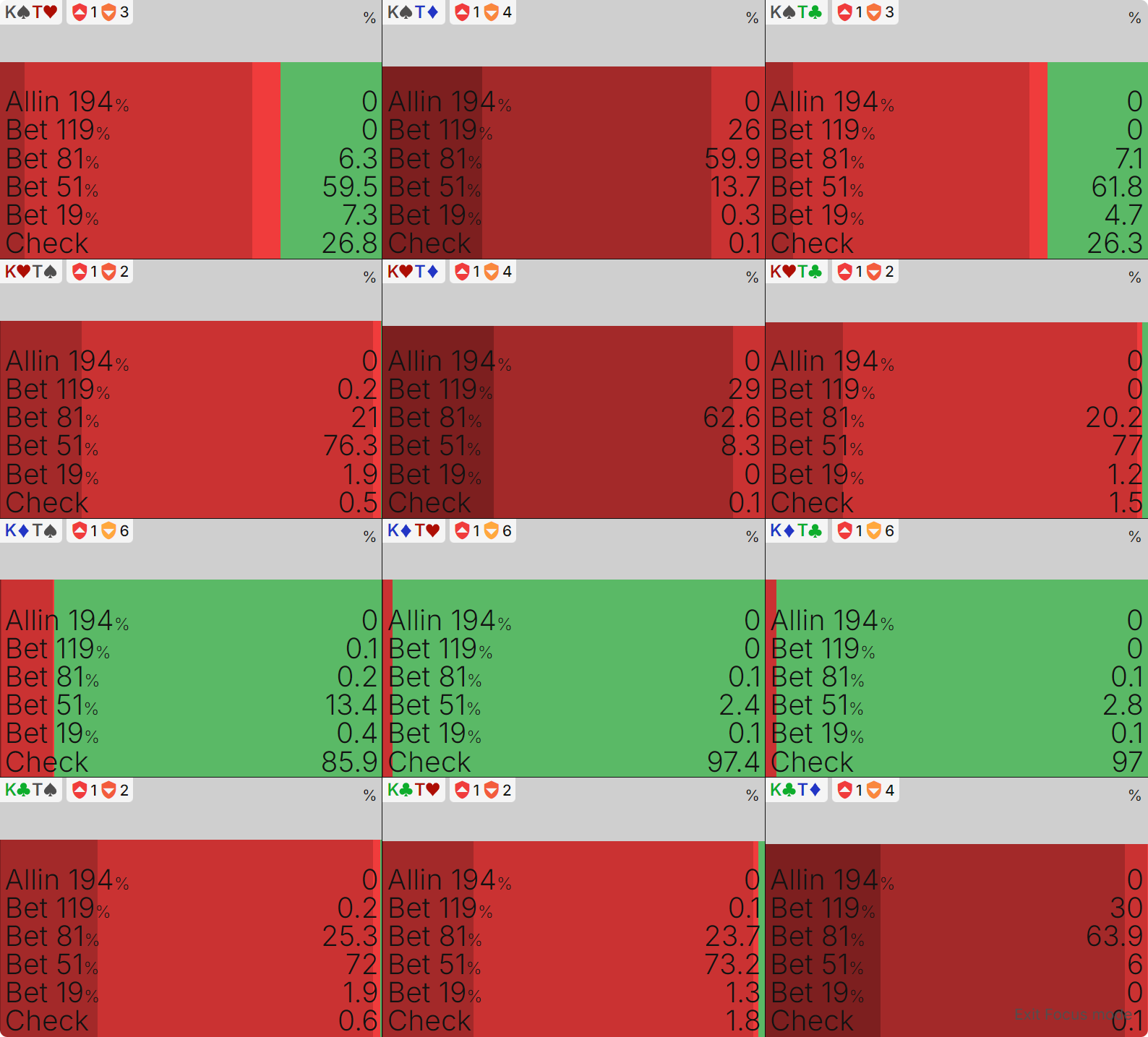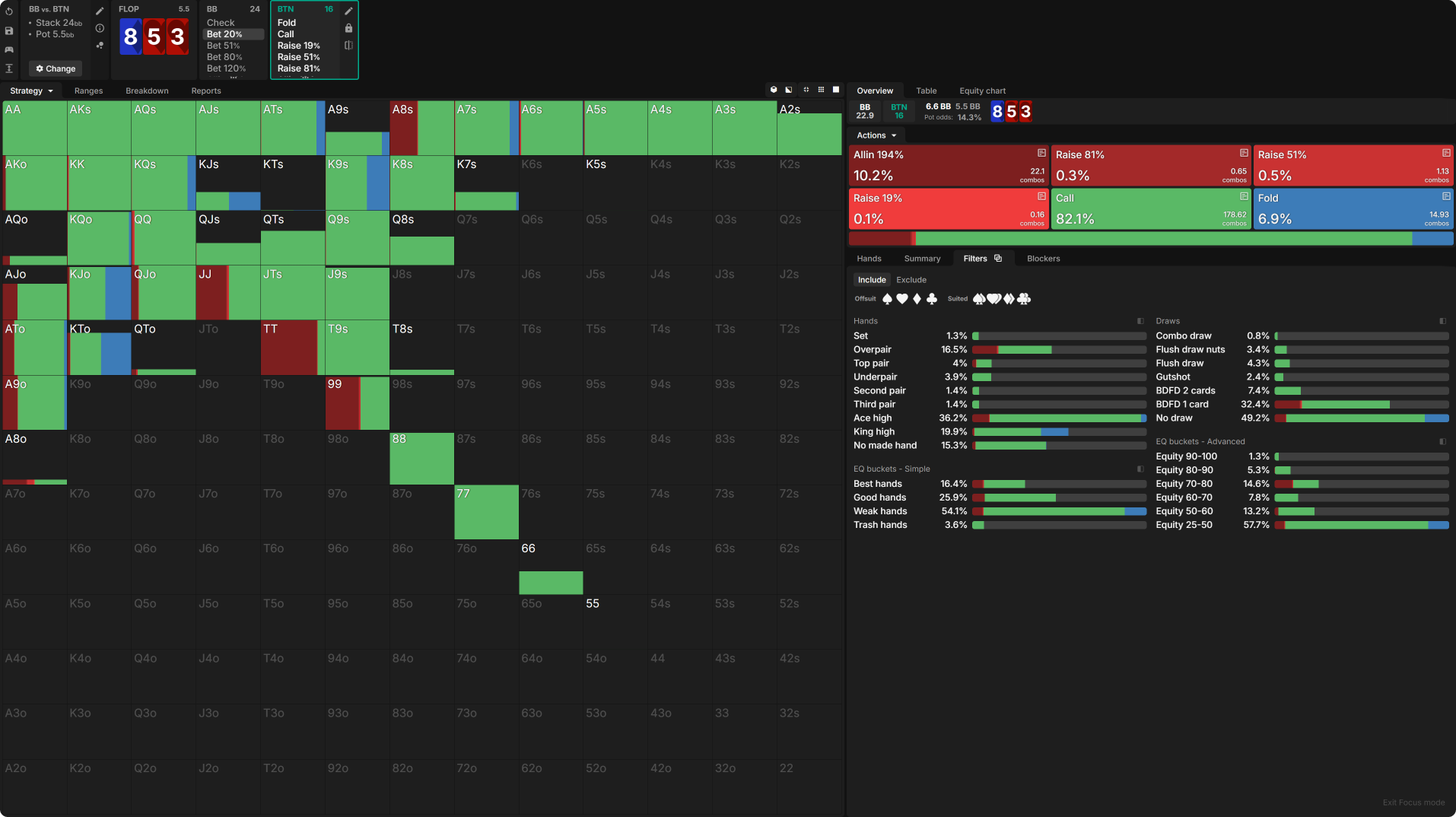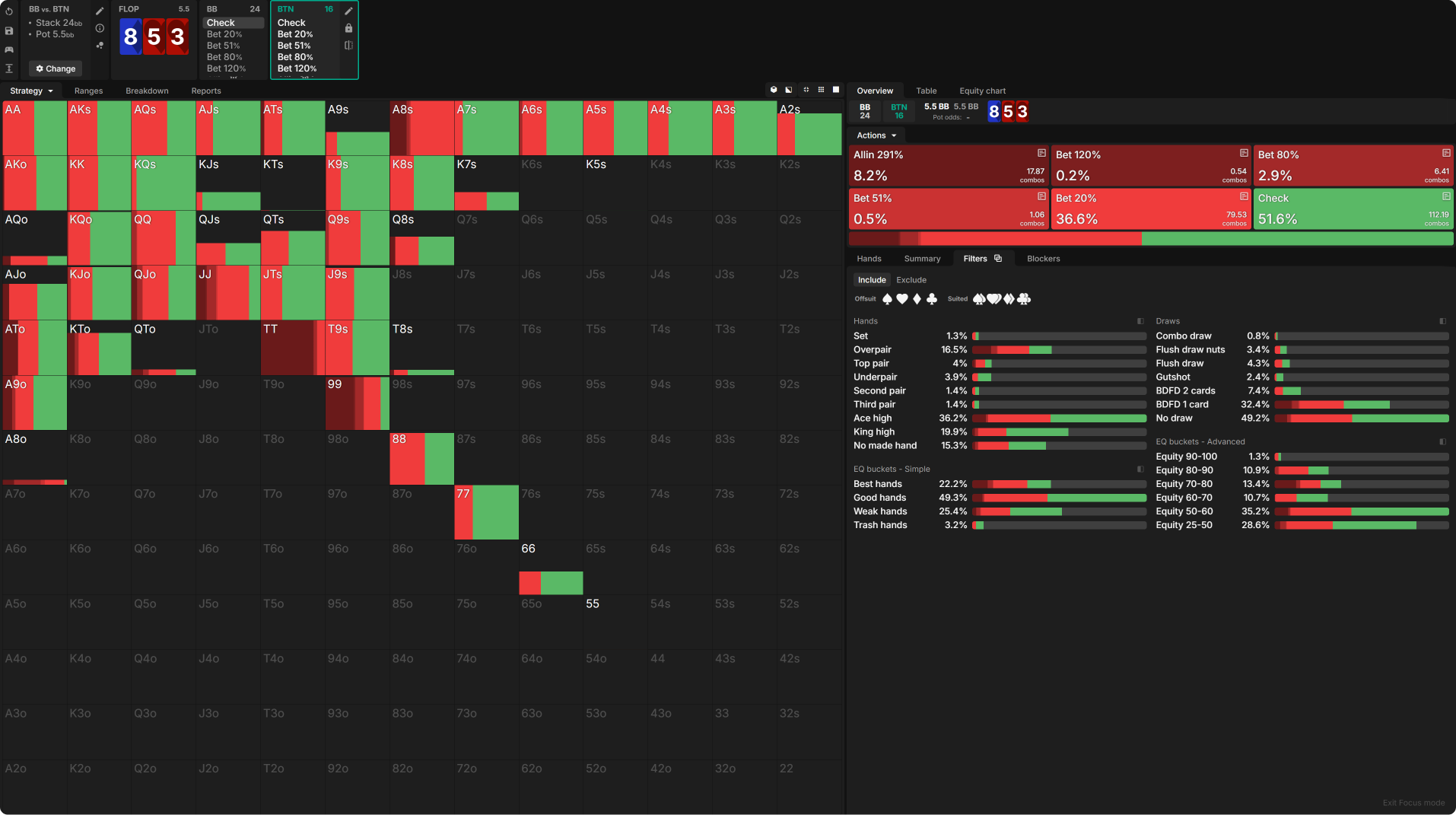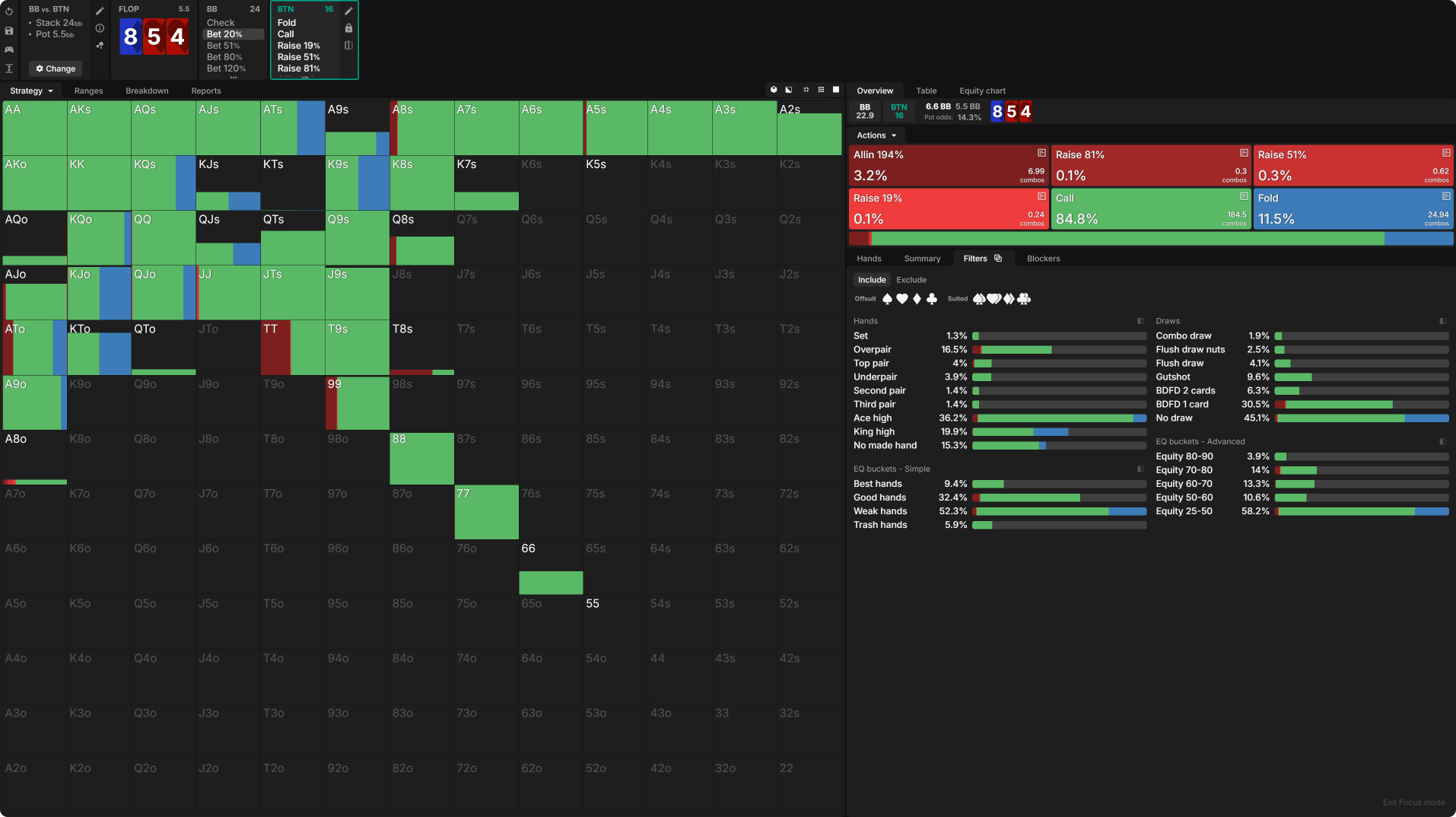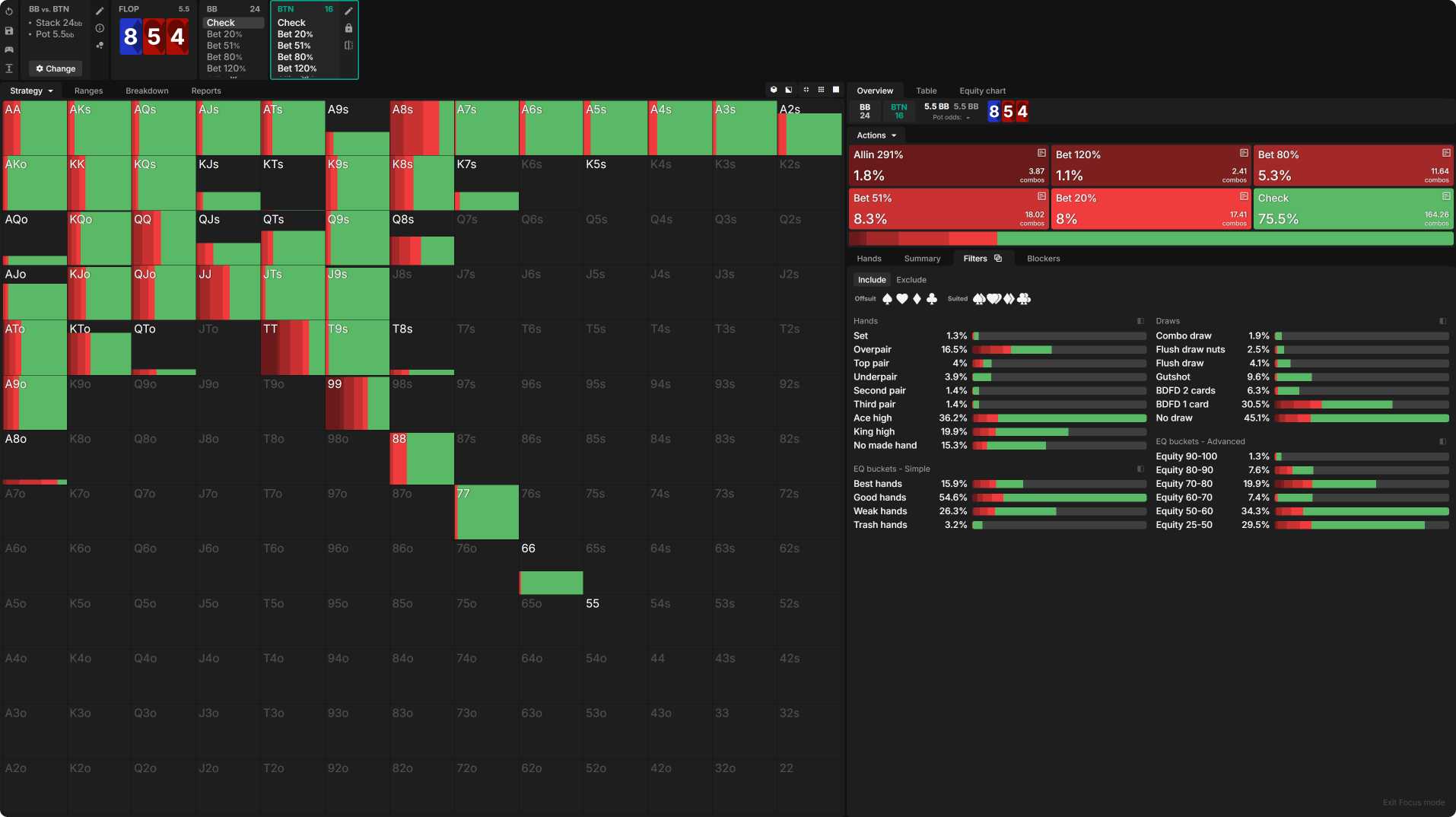Short Stack Stealing on the Bubble
Open-raising on the bubble into players who cover you is scary. Savvy opponents will recognize how dangerous it is for you to play a big pot on the bubble and look for opportunities to pressure you both before and after the flop.
Yet, there are hands strong enough to warrant contesting a pot on the bubble against covering players. Doing so profitably requires walking a fine line between getting value, protecting equity, and protecting what remains of your stack. Above all, it requires an awareness of your own range and the ability to leverage the strength of your opening range to help you win the pot even when your current hand is not strong.
This article will examine an SRP near the bubble between a somewhat short-stacked BTN and a covering BB. We will look at how preflop incentives shape postflop play, which should follow radically different patterns depending on the characteristics of the flop. While the exact ranges and strategies discussed here will be specific to these parameters (stack sizes, positions, tournament field size), the general principles will apply to other scenarios where the preflop raiser has a much higher risk premium than a caller from the blinds.
Preflop Considerations
Making sense of postflop play in this scenario requires understanding the preflop incentives that nudge the players to see the flop with very different ranges. Earlier in the tournament, BTN and BB ranges are somewhat similar in an SRP, with both players incentivized to play many quite modest hands. But in this bubble case, a short-stacked BTN in particular should have a much stronger range.
Consider the predicament: it folds to you on the BTN, with just two players remaining to act behind. You would love to steal the blinds and antes, which would increase your stack by more than 10%. But risking elimination so close to the bubble is an expensive proposition; few hands will be strong enough to stand up to the pressure that can be generated by the covering stacks in the blinds.
Does that mean you should only open with hands that can stand up to that pressure?
That could be a good adjustment against over-aggressive blinds, but there are two fundamental problems with this overly conservative strategy:
- Precisely because opening on the bubble is so risky, your opponents should expect you to be strong when you do it, which reduces their incentive to pressure you.
- You will often end up playing postflop, usually against a BB caller. You’d prefer to minimize your opponent’s ability to predict which boards you will or will not be strong on (because that could result in pressure as well).
If your opening range is too wide, you’ll be vulnerable to 3-bets and other sorts of pressure from covering players. But if it is too tight, you may miss out on profitable steals.
Just as in any other situation in poker, your default should be a balanced range unless you have an intentionally crafted exploitative strategy based on reads on the players behind you. Of course, you’ll need a much better hand than usual to continue to a 3-bet, so your value range will be smaller, and that will necessitate a tighter range of “light” opens as well. But you should be capable of opening both.
A helpful way of conceptualizing this is that folding in a tournament always has EV greater than $0 because your stack gains value whenever other players are eliminated, even if they are not at your table. On the bubble, the BTN’s value of folding is much greater than $0 because it will practically guarantee a min-cash. Raising can still be correct, but the EV of doing so must be greater than the EV of folding, and that’s a high bar.
The ideal candidates for the bottom of your opening range block your opponents’ 3-betting ranges and retain good equity when called. That means even your raise/folds should be mostly big, ideally suited cards.
In the example we’ll be considering, the BTN is opening off an 18bb stack into an SB with 41bb and a BB with 26bb. The average stack is 35bb, very close to the bubble of a 1000-runner tournament.
None of these players want to lose a big pot, but it is far worse for BTN, who risks elimination and the loss of the minimum prize they could almost certainly secure by folding. As a result, BTN has a bubble factor of 1.98, while BB’s bubble factor against BTN is 1.3 and SB’s is just 1.1:
BTN opens 17% of hands and jams another 2%, totaling 19%. This is a far cry from the ~50% opening frequency we should expect earlier in the tournament. Their raising range is heavy on Ace-x and King-x, and less studied players who never shove will be heavier still, with quite a few more offsuit Ace-x combinations in their range:
Despite the strength of BTN’s opening range and some ICM pressure of their own, BB calls a much wider and more diverse range, folding only small, disconnected, offsuit hands:
BB is getting great odds to call and, as the covering stack, can anticipate some advantages when playing postflop. BTN should be playing cautiously, resulting in BB getting more free cards and cheap showdowns when they want them. BB can also use BTN’s somewhat predictable range and the threat of the bubble to get some efficient bluffs and equity denial.
With BTN tightening up dramatically and BB somewhat less so, relative to comparable spots earlier in the tournament, we should expect to see a significant equity advantage for BTN on most flops. However, their emphasis on Ace-x and King-x hands in their raising range also means that while flops with big cards will be especially good for them, they will be more vulnerable on low card flops, especially those where BB can flop straights. They must play defensively on these flops, as BB should attempt to use their nuts advantage to apply pressure on these disadvantageous (for BTN) flops.
We will examine BTN’s strategy heads-up against a BB caller on four flops:
Ace-Low-Low
BTN enjoys an enormous range advantage on A♠6♦2♦, with 68.5% equity to BB’s 31.5% and a nuts advantage to boot.
This follows straightforwardly from the preflop ranges we have discussed already. BTN’s range is heavy on Ace-x, while BB’s is diluted by many hands that miss this flop. Even the non-Ace cards (6 and 2) do not connect well with BB’s range because they mostly fold their small offsuit cards preflop.
Thus, BB will struggle to defend their equity to even a small bet, and BTN basically min-bets their entire range when checked to:
BTN’s response to a half-pot raise—BB’s most commonly used raise size—is also simple. There are a few cases where they call with a backdoor draw or fold a small pair without one, but mostly, they call if they have a pair or a flush draw and fold if they don’t.
If you must play a pot on the bubble against a covering stack, you want easy decisions, so this is about as good as it gets. BTN’s turn-barreling strategy is designed to offer easy decisions as well, which is to say, on a neutral turn like the 8♥, it’s a big, polar bet with a strong Ace or better for value and unpaired trash for the bluffs:
That means BTN is not barreling draws here, unless they also have top pair:
Even blocking big diamonds is undesirable because flush draws will make up much of BB’s folding range on the turn:
It’s usually not so easy to push opponents off 9-out draws, but in this case, because of the general strength of BTN’s range on this board and the fact that BB is also under some ICM pressure makes it feasible.
If you must play a pot on the bubble against a covering stack, you want easy decisions.
Ace-Broadway-Low
As good as the A62 flop was for BTN, A♠Q♥2♦ is better still. BTN has more than 74% of the equity and captures 85% of the EV! Yet, they continuation bet considerably less often on this flop:
This is because more than half of BB’s range flops less than 20% equity!
BTN almost always pairs up on this flop, and when they don’t, they often have a gutshot and two live cards (in fact, they are somewhat often ahead even when they miss). The bottom of BB’s range, hands like 75o, are drawing nearly dead against BTN’s pairs.
When BTN flops a medium-strength hand that they don’t want to play a large pot with (e.g., QJ, A♣5♣, or JJ), they have little incentive to bet. Some of these hands, like JJ, perform poorly against BB’s calling range. Others, like A5, will be strong enough to bet later if BB keeps checking but aren’t looking to play for stacks, so sacrifice little by checking. They don’t care about pushing the bottom of BB’s range off its equity, nor are they looking to grow a pot against the top of that range. Betting these hands would not lose money, but it would mostly result in taking down pots BTN would have won anyway by checking.
BTN has a few traps at the very top end of their range, where they block much of what would call multiple bets. But they don’t slow-play often, because the rest of their checking range is strong enough that BB won’t be terribly tempted to bluff into it. BTN never checks their worst hands, however; when they check, it’s with stuff like J♥T♥ and 66, which retains some equity it would have lost by betting, especially if raised.
These hands, even the small pairs, won’t check all the way to showdown unimproved. After BTN checks the flop, they will be the new bottom of the range and will eventually bluff if BB keeps checking.
Once again, we see a polar strategy that largely avoids tough decisions by checking the hands that don’t want to get raised or play for large pots.
Low Disconnected
8♦5♥3♥ is one of those flops that is obviously bad for BTN’s Broadway-heavy range. But it isn’t as bad as you might expect—BTN retains more than 55% of the equity and realizes about that much of the EV as well—but it isn’t nearly as good as the Ace-high boards we’ve investigated so far.
A lot of BTN’s equity is locked up in unpaired hands, which will face tough decisions on many runouts and would prefer not to grow the pot. If BB was forced to check, BTN would c-bet only about 12% of the time. By comparison, facing a forced check at an earlier stage of the tournament, BTN c-bets 63% of the time on this flop.
BB, not wanting to give BTN this comfortable option, has a lot of incentive not to check. At equilibrium, they donk-bet roughly half their range for 20% pot.
BTN’s response is simpler than you might think; they mostly call (folding only their most hopeless hands) and jam a narrow range heavy on strong but vulnerable pairs. Note that there are no flush draws in this jamming range!
Even on the bubble, you can peel pretty wide, getting 6:1 odds (before factoring in risk premium) in position. Remember that this calling range is quite strong, featuring sets, big pairs, and strong draws. It will not be trivial for BB to keep barreling turns, so BTN often gets to see two cards for this low price.
Facing a check, BTN actually shoves some of the same hands and bets a narrow range with more pairs and some draws and backdoor draws.
Keep in mind that this is an equilibrium strategy that factored in BB’s incentive to donk-bet many of their strongest hands. If you believe your human opponent would not have a donking range, you can exploit that by betting less often.
Playing later streets on this dynamic board will require an awareness of your own range. Your range is heavy on Broadway cards, so on Broadway turns, you can bet more aggressively. If you face bets on those turns, you don’t need to get too stubborn about defending because you’ll have many naturally strong hands. On blank turns, it will be correct to continue with more of your best unpaired hands, especially if the bet is small.
Low Connected
8♦5♥4♥ is a truly bad flop for BTN. They actually still have a slight equity advantage, but BB captures nearly 58% of the EV. They flop enough sets, straights, and two pairs (of these, BTN has only 88) to support a robust bluffing range and deter BTN from raising, especially because they also flop more pairs than BTN. Their equilibrium strategy is to lead their entire range!
BTN’s response is actually pretty similar to the 853tt flop, with few folds and even fewer shoves:
When you’re fortunate enough to face a check, you should be grateful for the free turn and not bet terribly often. This is BTN’s equilibrium c-betting strategy:
Because checking is not really a part of BB’s equilibrium strategy, however, any human player checking to you in this spot is likely doing so exploitably. And the exploit against a player who never donk-bets here is to check back your entire range.
Conclusion
Not all flops encourage such extreme strategies, but by studying the extremes, we can build intuition around how to approach most flops. The King-high flops will play more similarly to the Ace-high ones. The lower flops will play more similarly to 853 or 854, depending on how connected they are. And so on.
At the beginning of this article, I said that, when opening from the BTN, “you’d prefer to minimize your opponent’s ability to predict which boards you will or will not be strong on.” Since then, it seems like we’ve talked about nothing except how some cards are obviously good for BTN and some obviously bad. What gives?
The key word here is “minimize.” Your preflop incentives force you to be somewhat predictable. There’s real value in blocking the blinds’ strongest hands, which you capture by opening mostly hands with an Ace or King in them. The key is to recognize what your opponent can deduce about your range based on this and play around it.
You don’t want to go broke on the bubble, but that doesn’t mean you immediately wave the white flag when you miss the flop. Your opponent, getting a great price and incentivized to bully you, will often miss the flop themselves, and you can leverage the stronger hands in your range to protect the weaker ones.
On Favorable Boards
On boards that strongly favor you, that means betting a polarized range, coupling your strong hands with your weak hands while checking medium-strength hands for delayed value or a cheap showdown. This is why 66 bluffs on AQX, even though it may have some showdown value. You have so few weak hands on this board that it is more profitable to bluff than to showdown a weak pair.
On Not-So-Favorable Boards
On boards that aren’t supportive of your range, it means more calling and checking, even with your strongest hands, so your range is uncapped and dangerous to bet into. This minimizes (but doesn’t eliminate) their ability to use bubble pressure and an unfavorable board against you.
Above all, the main takeaway of this article is the following:
Contesting pots against covering stacks on the bubble, requires accepting that you’ll have to face some uncomfortable spots, make some uncomfortable tradeoffs, and generally under-realize your equity.
You must place a high premium on the last of your chips, and that will sometimes mean foregoing a protection-bet or even folding a hand that could easily be best.
When you raise preflop, you really want the blinds to fold. When they don’t, you’ve got to make the best out of a bad situation. Sometimes the flop bails you out, but you should not expect to win as many pots or get as much value as you would at earlier stages of the tournament. Survival must take precedence!
Author
Andrew Brokos
Andrew Brokos has been a professional poker player, coach, and author for over 15 years. He co-hosts the Thinking Poker Podcast and is the author of the Play Optimal Poker books, among others.
Wizards, you don’t want to miss out on ‘Daily Dose of GTO,’ it’s the most valuable freeroll of the year!
We Are Hiring
We are looking for remarkable individuals to join us in our quest to build the next-generation poker training ecosystem. If you are passionate, dedicated, and driven to excel, we want to hear from you. Join us in redefining how poker is being studied.




